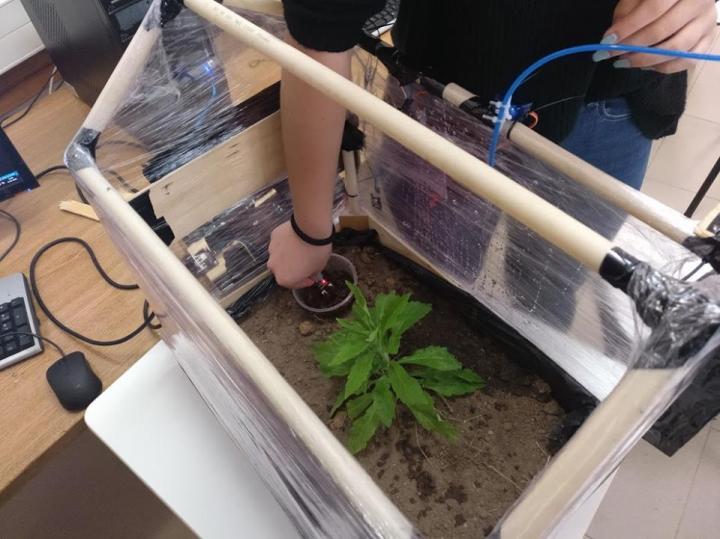Από τον σπόρο στην κομποστοποίηση: ο φυσικός κύκλος της ύλης Βρείτε από που έρχεται το φαγητό στο πιάτο σας για να κατανοήσετε την παγκόσμια προσφορά τροφίμων

Έτοιμοι για δράση;
Τι
Πιθανές συνδέσεις με το αναλυτικό πρόγραμμα
Ποιος
Οι άνθρωποι που αναλαμβάνουν τον ρόλο του/της εκπαιδευτικού
Πού
Οι χώροι όπου πραγματοποιούνται οι εκπαιδευτικές δράσεις
Με
Τα μέλη της κοινότητας για ευκαιρίες συνεργασίας
Σύντομη περίληψη
Αυτό το πρότζεκτ εξετάζει δύο συγκεκριμένα σημεία της τροφικής αλυσίδας. Θα ξεκινήσει με το ταξίδι του φαγητού από το χωράφι ή το εργοστάσιο στο πιάτο. Κατόπιν θα ερευνήσει τι συμβαίνει όταν πετάμε τα υπολείμματα του φαγητού μας. Οι μαθητές θα αναλάβουν να κάνουν μια έρευνα για να εντοπίσουν την προέλευση των τροφών και τον τρόπο για να μειώσουμε τα τροφικά απόβλητα. Οι μαθητές θα πειραματιστούν με την κομποστοποίηση, την ανακύκλωση των τροφικών υπολειμμάτων για να γίνουν λίπασμα για την καλλιέργεια νέων τροφικών προϊόντων. Θα μάθουν τι απαιτείται για να πραγματοποιήσουμε μια αποδοτική σπορά και μετά θα σχεδιάσουν έναν νέο σχολικό κήπο. Κατόπιν θα μοιραστούν όσα έμαθαν διοργανώνοντας μια έκθεση για την κοινότητά τους.
Students begin by researching the origin of the food they eat and finding out how many kilometres it travelled to reach their tables. Locations will be mapped, marking the path of each product with a string. Students will consider the impact these journeys have on local and global ecosystems.
Students will prepare questions for an expert related to the composting process, building composters, and the use of fertilisers. The expert will explain the composting process itself and answer questions. During the meeting, the students will write down the most important information in an interesting way.
Working in groups, students will build a composter, with each group being responsible for a different part of the composter. After construction is completed, the materials to be composted will be placed inside. For the next 2 weeks, they will check the compost level every 2 days, measure the temperature, and record their observations.
Students will conduct experiments during which they investigate what can be placed in the composter, which products decompose faster, and what speeds up composting.
Students will learn about the effect of fertilisation on the nutritional value of soil. They will learn how to make a soil acid meter, then take soil samples from different places, determining their pH. They will observe the plants at the sampling site. After discussing different types of fertilisers: mineral, natural and plant residues, students will mix their soil samples with various fertilizers and check how the pH of the samples change.
Students will design a garden based on data. They will analyse what plants need to provide the right conditions for growth. On the basis of their previous knowledge, they will gather the materials they need and begin work on the garden.
Students will prepare an event for the local community and parents at the community garden created as part of the project. Photo panels will be mounted on the fence or in the garden, and they will prepare a film to project onto the facade of the building. If possible, they will also present the first crops of the garden.
Ανατροφοδότηση εκπαιδευτικού
Ιδιαίτερες στιγμές
Δύσκολες στιγμές
- Ο κομποστοποιητής και ο κήπος μας ήταν υπερβολικά μεγάλοι. Χρειάστηκε πολύς χρόνος για να τους φτιάξουμε και στη συνέχεια να τους παρατηρήσουμε. Αν είχαμε να διαχειριστούμε μικρότερα μεγέθη, το πρότζεκτ μας θα ήταν πιο αποτελεσματικό χωρίς να επηρεαστούν τα μαθησιακά αποτελέσματα.
- Οι μαθητές μοιράστηκαν τα φυτά που φρόντισαν. Δυστυχώς, όμως, κάποια μαράθηκαν, με αποτέλεσμα να στεναχωρηθούν και να μην είναι πλέον τόσο πρόθυμοι να ασχοληθούν με το πρότζεκτ.
Γενικές συμβουλές
- Αν δεν έχετε χώρο και θέλετε να εξοικονομήσετε χρόνο, αντί να κατασκευάσετε κομποστοποιητή, χρησιμοποιήστε μικρά ξύλινα κουτιά - κάνουν καλή δουλειά. Αντί να σκάψετε τον κήπο, μπορείτε να χρησιμοποιήσετε γλάστρες που θα τις τοποθετήσετε στο περβάζι του παραθύρου.